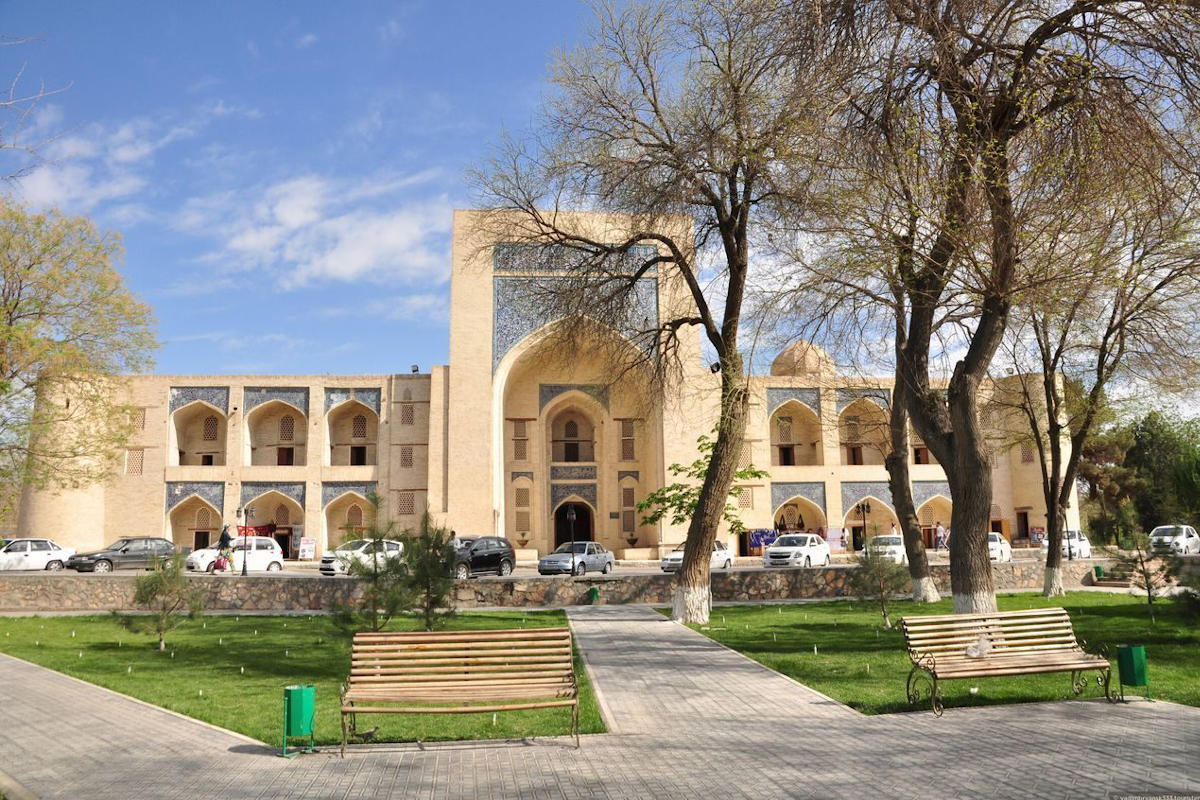Bukhara - Kukaldash Madrasah

The Kukaldash Madrasah in Bukhara: a masterpiece of Central Asian architecture
One of the most famous sights in Bukhara, the Kukaldash Madrasah, is located in the immediate vicinity of the Labi-Hauz architectural complex. This impressive educational facility was built between 1568 and 1569 and is considered the largest madrasah in Bukhara and one of the largest of its kind in Central Asia.
The name ‘Kukaldash’ is widespread in the region and means ‘sun friend’ or ‘milk brother’. Interestingly, there is a madrasah of the same name in Tashkent, which points to the cultural connection between the two cities.
The architecture of the Kukaldash Madrasah in Bukhara clearly stands out from the traditional building styles of its time. While most madrasas of that era were built according to a standardised model – with majestic structures, luxurious entrance groups and massive walls – the Kukaldash Madrasah deliberately broke with these conventions. The walls of the building are by no means plain; on the contrary, numerous niches and balconies with ornate ganche ornaments adorn the building. The madrasah houses a total of 160 cells spread over two floors, which are grouped around a central courtyard.
The medrese was built during the reign of Abdullakhan II and was financed by the influential Emir Kulbab. Kulbab earned the respect of the population through his wisdom and diplomacy and was given the honourable title of ‘Kukaldash’. In recognition of his contribution, the madrasah was later named after him.
Contrary to popular belief, the Kukaldash Madrasah is not an integral part of the Labi Hauz ensemble. Archaeological investigations have shown that it is an independent building that was erected independently of the other buildings in the area.
The Kukaldash Madrasah is an impressive example of 16th century architecture. Its unique architectural design, the harmonious combination of functionality and aesthetics as well as its rich history make it an indispensable part of Bukhara’s cultural heritage. To this day, it fascinates visitors from all over the world and remains a living testimony to Central Asia’s glorious past.
The Kukaldash madrasah, an outstanding architectural monument in the history of Central Asia, has undergone numerous transformations over the years. Originally not built as a madrasah, the building has repeatedly changed its purpose. At one stage in its history, it was even used as a caravanserai. The construction of the madrasah attracted the most talented and famous craftsmen and masters of the time, who were involved in the design and construction of the imposing building.
The architectural beauty of the madrasah is best known for its ornate ganch arches, which come together in a dense network to form a stunning, vaulted structure. These arches not only create a visual fascination, but also represent a technical masterpiece of the architecture of the time. In addition, the gates of the madrasah are decorated with breathtaking mosaics that were attached without the use of glue or nails. The geometric ornamentation on the front entrance group emphasises the fine craftsmanship and attention to detail of the builders.
Over the centuries, the building has survived numerous events, including a devastating earthquake that severely damaged the structure. The portal in front of the building was particularly badly damaged and was initially repaired with makeshift metal brackets. However, the tireless efforts of the craftsmen and restorers to preserve the building prevented the historical heritage from completely deteriorating.
During the reign of Beklar Begi, bricks were used to construct the upper floor of the madrasah and create the stunningly beautiful sky-blue domes. These domes are now a defining feature of the building and a symbol of the combination of traditional architecture and contemporary restoration. Thanks to the tireless work of talented craftsmen, the madrasah has retained its historical charm and cultural significance to the present day.
However, the Kukaldash madrasah is not only important from an architectural point of view. It also plays a central role in modern history. A prominent part of this history is the building’s connection with the famous Central Asian writer Sadriddin Ayni. Ayni lived for a long time in one of the cells of the madrasah, where he wrote his important literary works. Although he died in the middle of the 20th century, his literary legacy remains immortalised. Today, the writer’s name is inextricably linked with the Kukaldash madrasah: A small memorial has been erected inside the building in his honour. In addition, some of his personal belongings and handwritten manuscripts are on public display and bear witness to his unmistakable importance for the literature of the region.
The Kukaldash madrasah is thus not only an architectural masterpiece, but also a cultural and historical symbol that preserves and celebrates the rich history and heritage of Central Asia.
